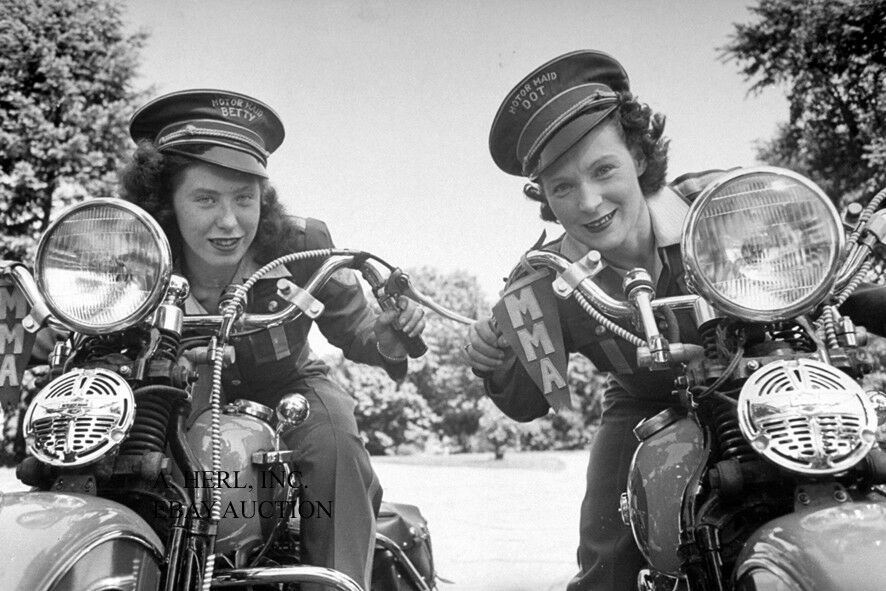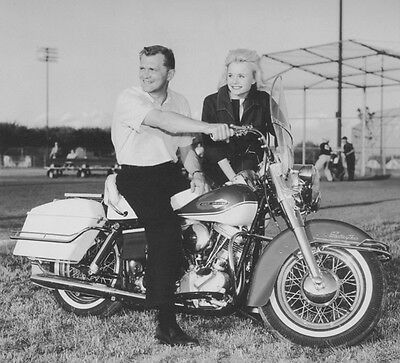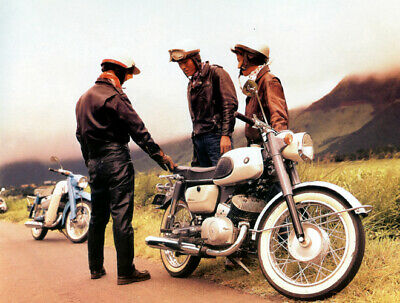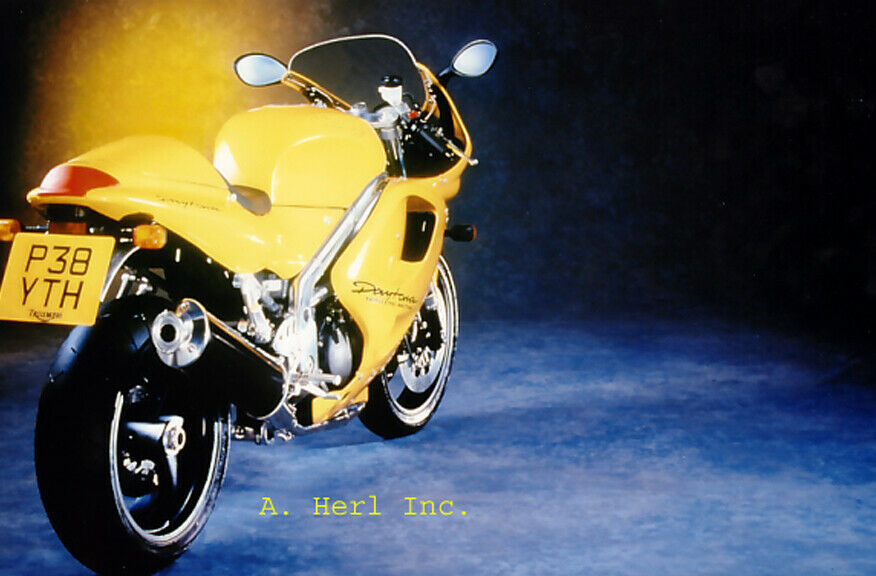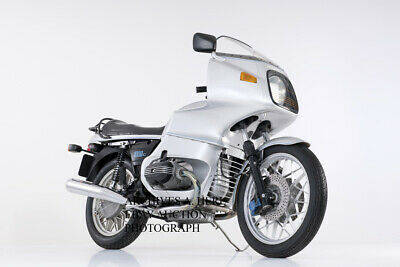-40%
Triumph 250 Special sidecar motorcycle racing photo photograph
$ 5.14
- Description
- Size Guide
Description
WEARE
CLEARING OUT OUR ARCHIVES!
A superb and rare photo of the
Triumph 250cc Special with sidecar.
Triumph Motorcycles
was originally based in
Coventry
. A new company in
Hinckley
took over the name rights after the collapse of the company in the 1980s. The company began in 1885 when Siegfried Bettmann emigrated to
Coventry
in
England
from
Nuremberg
, part of the German Empire. In 1884 aged 20, Bettmann founded his own company, the S. Bettmann & Co. Import Export Agency, in
London
. Bettmann's original products were bicycles, which the company bought and then sold under its own brand name. Bettmann also distributed sewing machines imported from
Germany
. In 1886, Bettmann sought a more universal name, and the company became known as the Triumph Cycle Company. A year later, the company registered as the New Triumph Co. Ltd., now with financial backing from the Dunlop Pneumatic Tyre Company. In that year, Bettmann was joined by another
Nuremberg
native, Moritz Schulte. Schulte encouraged Bettmann to transform Triumph into a manufacturing company, and in 1888 Bettmann purchased a site in
Coventry
using money lent by his and Schulte's families. The company began producing the first Triumph-branded bicycles in
1889. In
1896, Triumph opened a subsidiary, Orial TWN (Triumph Werke Nuremberg) a German subsidiary for cycle production in his native city. In 1898, Triumph decided to extend its own production to include motorcycles and by 1902, the company had produced its first motorcycle - a bicycle fitted with a Belgian-built engine. In 1903, as its motorcycle sales topped 500, Triumph opened motorcycle production at its unit in
Germany
. During its first few years producing motorcycles, the company based its designs on those of other manufacturers. In 1904, Triumph began building motorcycles based on its own designs and in 1905 produced its first completely in-house designed motorcycle. By the end of that year, the company had produced more than 250 of that design. In 1907, after the company opened a larger plant, production reached 1,000 bikes. Triumph had also launched a second, lower-end brand, Gloria, produced in the company's original plant. The outbreak of World War I proved a boost for the company as production was switched to support the Allied war effort. More than 30,000 motorcycles - among them the Model H Roadster aka the "Trusty Triumph," often cited as the first modern motorcycle - were supplied to the Allies. Bettmann and Schulte fell out after the war, with Schulte wishing to replace bicycle production with cars. Schulte left the company, but in the 1920s Triumph purchased the former Hillman car factory in
Coventry
and produced a saloon car in 1923 under the name of the Triumph Motor Company. Harry Ricardo produced an engine for their latest motorbike. By the mid-1920s Triumph had grown into one of
Britain
's leading motorcycle and car makers, with a 500,000 square feet (46,000 m2) plant capable of producing up to 30,000 motorcycles and cars each year. Triumph also found its bikes in high demand overseas, and export sales became a primary source of the company's revenues, although for the
United States
, Triumph models were manufactured under license. The company found its first automotive success with the debut of the Super Seven car in 1928. Shortly after, the Super Eight was born. When the Great Depression hit in 1929, Triumph spun off its German subsidiary as a separate, independently owned company, which became part of the Triumph-Adler Company. The
Nuremberg
firm continued to manufacture motorcycles under the Triumph brand until
1957. In
1932, Triumph sold off another part of the company, its bicycle manufacturing facility to
Raleigh
. By then, Triumph had been struggling financially, and Bettmann had been forced out of the chairman's spot. He retired completely in
1933. In
1936, the company's two components became separate companies. Triumph always struggled to make a profit from cars, and after going bankrupt in 1939 was acquired by the Standard Motor Company. The motorcycle operations fared better, having been acquired in 1936 by Jack Sangster, who also owned the rival Ariel motorcycle company. That same year, the company began its first exports to the
United States
, which quickly grew into the company's single most important market. Sangster's formed the Triumph Engineering Co Ltd largely led by ex-Ariel employees, including Edward Turner who designed the 500 cc 5T Speed Twin - released in September 1937, and the basis for all Triumph twins until the 1980s. Contrary to popular belief, however, this was not Triumph's first parallel twin. This honour falls to the Val Page designed, but unpopular, 6/1. After Turner arrived, in his usual brusque manner, the 6/1 was dropped, later to be replaced with Turner's design. The 6/1 engine later resurfaced, somewhat modified, as the BSA A10. In 1939 the 500 cc Tiger T100, capable of
100 miles
per hour (
160 km/h
), was released, and then the war began. Motorcycles were produced at
Coventry
until World War II. The town of
Coventry
was virtually destroyed in The Blitz (September 7, 1940 to May, 1941). Tooling and machinery was recovered from the site of the devastation and production restarted at the new plant at
Meriden
,
West Midlands
in 1942. (It was actually the
village
of
Allesley
, which was difficult to find on a map!) One of Triumph's wartime products is of particular interest: portable generators for the RAF, using 500 cc Triumph engines with alloy barrels. The Speed Twin designed by Edward Turner before the war was produced in large numbers after the war. Efforts to settle the lend-lease debts caused nearly 70% of Triumphs post war production to be shipped to the
United States
. Post War, the Speed Twin and Tiger 100 were available with a sprung rear hub, Triumph's first attempt at a rear suspension. Privateers put wartime surplus alloy barrels on their Tiger 100 racers, and won races, inspiring the Triumph GP model. By 1950 the supply of barrels was exhausted, and the GP model was dropped. The American market applied considerable pressure to reverse this backward step, and a die cast close finned alloy barrel was made available. The alloy head made the valve noise more obvious, so ramp type cams were introduced for alloy head models to reduce the noise. Another motorcycle based on the wartime generator engine was the 499 cc TR5 Trophy Twin, also introduced at the 1948 Motor Cycle Show. It used a single carburettor, low compression version of the Grand Prix engine.
Britain
won the prestigious 1948 International Six Days Trial. The Triumph works team had finished unpenalised. One team member, Allan Jefferies, had been riding what amounted to a prototype version. To satisfy the American appetite for motorcycles suited to long distance riding, Turner built a 650 cc version of the Speed Twin design. The new bike was named the Thunderbird (A name Triumph would later license to the Ford Motor Company for use on a car). In 1950 Bobby Turner in
Southern California
set many speed records with a highly tuned version of the 650 Thunderbird. Several other riders like Ed Kretz and Blackie Blullock used the same machine, nicknamed “Wonderbird” also in speed record events and racing. Amazingly, the Thunderbird engine, its design origins from 1939, held the world's absolute speed record for motorcycles from 1955 until 1970. The Triumph brand received considerable publicity in the
United States
when Marlon Brando rode a 1950 Thunderbird 6T in the 1953 motion picture, The Wild One. The Triumph Motorcycle concern was sold to their rivals BSA by Sangster in 1951. This sale included Sangster becoming a member of the BSA board. Sangster was to rise to the position of Chairman of the BSA Group in 1956. The production 650 cc Thunderbird was a low compression tourer, and the 500 cc Tiger 100 was the performance bike. That changed in 1954, with the change to swing arm frames, and the release of the alloy head 650 cc Tiger 110, eclipsing the 500 cc Tiger 100 as the performance model. In 1959, the T120, a tuned double carburettor version of the T110, came to be called the Bonneville. As Triumph and other marques gained market share, Harley became aware that their 1 litre-plus bikes were not as sporty as the modern rider would like, resulting in a shrinking share of the market. The Triumphs were models for a new, "small" Harley Davidson as a result: the now-fabled Sportster, which started out as Harley's version of a Triumph Bonneville. With its anachronistic V-twin, the Sportster was no match for the Bonneville, but it proved a solid competitor in
US
sales and eventually also in longevity. In the 1960s, despite internal opposition from those who felt that it would dilute the macho image of the brand, Triumph produced two scooters; the Triumph Tina, a small and low performance 2-stroke scooter of around 100 cc with automatic clutch and a handlebar carry basket, and the Triumph Tigress, a more powerful scooter available with either a 175 cc 2-stroke single or a 250 cc 4-stroke twin engine for the enthusiast. In 1962, the last year of the "pre-unit" models, Triumph used a frame with twin front down-tubes, but returned to a traditional Triumph single front downtube for the unit construction models that followed. The twin down tube, or duplex frame, was used on the 650 twins, as a result of frame fractures on the Bonneville. Introduced in 1959, for the 1960 model year, it soon needed strengthening, and was dropped in 1962, with the advent of the unit engines for the 650 range. The 3TA (21) was the first unit construction twin, soon followed by the short-stroke, 490 cc "500" range. From 1963 all Triumph engines were of unit construction. In 1969 Malcolm Uphill, riding a Bonneville, won the Isle of Man Production TT with a race average of 99.99 miles per hour (160.92 km/h) per lap, and recorded the first ever over
100 miles
per hour (
161 km/h
) lap by a production motorcycle at 100.37 miles per hour (161.53 km/h). For many Triumph fans, the 1969 Bonneville was the best Triumph ever. American sales had already peaked, in
1967. In
truth, the demand for motorcycles was rising, but Triumph could not keep up. In the 1960s, 60% of all Triumph production was exported, which, along with the BSA's 80% exports, made the group susceptible to the Japanese expansion. By 1969 fully 50% of the
US
market for bikes over 500 cc belonged to Triumph, but technological advances at Triumph had failed to keep pace with the rest of the world. Triumphs lacked electric start mechanisms, relied on push-rods rather than overhead cams, vibrated noticeably, often leaked oil, and had antiquated electrical systems; while Japanese marques such as Honda were building more advanced features into attractive new bikes that sold for less than their British competitors. Triumph motorcycles as a result were nearly obsolete even when they were new; further, Triumph's manufacturing processes were highly labour-intensive and largely inefficient. Also disastrous, in the early 1970s the
US
government arbitrarily mandated that all motorcycle imports must have their shift and brake pedals in the Japanese configuration, which required expensive retooling of all the bikes for
US
sale. The British marques were poorly equipped to compete against the massive financial resources of Japanese heavy industries that targeted competitors for elimination via long-term plans heavily subsidized by the Japanese government. Triumph and BSA were well aware of Honda's ability but while the Japanese were only making smaller engined models, the large engine market was considered safe. When the first Honda 750 cc four cylinder was released for sale to the public, Triumph and BSA were facing trouble. A 3-cylinder engined motorcycle was developed to compete against the Japanese fours: the BSA Rocket 3/Triumph Trident. The 1970 Tiger/Bonneville re-design and taller twin front downtube oil tank frame met a mixed reception from Triumph enthusiasts at the time, and was insufficient to win back those already riding the Japanese bikes that had hit the markets in 1969; the Honda 750 Four, and the Kawasaki 500 Mach 3. The Triumph 350 cc Bandit received pre-publicity, before being quietly shelved. Triumph was still making motorcycles, but they no longer looked like the bikes Triumph fans expected. The Trident attracted its own market, but the Japanese bikes were improving more rapidly. Harley Davidson had responded to Triumph's earlier marketing success by producing sportier models that retained the engine design traditional Harley owners identified with, and had managed to survive. Triumph did not manage to do as well with its redesign. Problems were compounded in 1970 by difficulties with parts supply and the labour force. In
1971 a
five speed gearbox was introduced. The parent BSA group made losses of 8.5 million pounds in 1971, 3 million for BSA motorcycles alone. The British government became involved. The company was sold to Manganese Bronze Holdings, which also owned Norton, AJS, Matchless, Francis-Barnett, James-Velocette and Villiers. A new company called Norton Villiers Triumph (NVT), managed by Dennis Poore, emerged. When the BSA group collapsed under its debts, government help led to a merger with the Manganese Bronze Holdings subsidiary Norton-Villiers. The three remaining brands to be produced by the company were combined to create the new group name of Norton-Villiers-Triumph (NVT). However, this restructuring would result in a number of closures and redundancies, due to the withdrawal of the Conservative government aid (as an inducement to Denis Poore to take on Triumph) by the then Labour Minister, Roy Hattersley. After many consulations with the factory personnel explaining the consolidation necessary to face the Japanese challenge, in September 1973 NVT Group chairman Denis Poore finally announced the closure of
Meriden
works effective February, 1974. Of 4,500 employees, 3,000 were made redundant. Faced with unemployment and having their products handed over to a rival firm, the workers at the Meriden factory demonstrated against a move to Small Heath, Birmingham, the BSA site and staged a sit in for two years. The Bonneville engine size was increased to 724 cc in 1973, and called a 750. Edward Turner died at home in his sleep on
August 15, 1973
. As scheduled, Trident production moved to the BSA factory in Small Heath in 1974, but as BSA used non-craft labour in manufacturing, quality fell dramatically. In October 1974 the Labour Government announced the formation of the Meriden Cooperative under Tony Benn, with a loan of £5 million - on the condition that NVT retained ownership of the name, and continued the sales and marketing of the machines. The cooperative resumed production in March 1975, but dropped production of the lightweight T120, to concentrate on the 750 cc twin machines, the Bonneville and the Tiger, primarily for the
USA
market. The cooperative needed additional cash, and agreed a deal with Lord Weinstock's GEC company to sell 2,000 Bonnevilles for £1,000,000 together with consultation on setting up a sales force. Meanwhile, NVT stopped production of the Trident in 1975, and also killed off the development of the 1000 cc Quadrent (often and mistakenly called the "Quadrant") due to cash flow difficulties. A number of key engineers left the company, including Henry Vale, Jack Wickes, Les Williams, Ivor Davies, Arthur Jakeman and Norman Hyde. In 1977, after fighting over who had rights to sell Triumph motorcycles for many years, NVT went bankrupt and the rights were sold to the Meriden Cooperative. The limited edition Silver Jubilee T140V was made to commemorate Queen Elizabeth's 25 years on the throne, a T140 Bonnie with hand-striped wheel rim, chromed engine cases and special sidecover badges. Nominally 1,000 were scheduled for the
UK
, 1,000 for the
US
, and about 400 more made for export later. The model sold well, and production increased slowly to 350 machines a week, 60% going to the
USA
. After this it was all downhill, with no investment in new machines, merely makeovers of the 750 cc twin. However, the Bonneville T140D won the "Machine of the Year" award in Motor Cycle News – a questionable honour this late in the bike's life, owing more to the bike's reputation than its competency against the (mostly Japanese) competition. The T140D had Lester cast alloy wheels, a new cylinder head with parallel intake tracts, Amal MKII carburettors, Lucas Rita electronic ignition system, and a lower 7.9:1 compression to reduce vibration. In 1980, debt reached £2 million pounds - additionally above the earlier £5 million loan. In October, the British government wrote off £8.4 million pounds owed by Triumph, but still left the company owing £2 million to Britain's Export Credit Guarantee Dept. Triumph experimented with several designs in its last years, none able to stop the decline. In 1981 the T140D Bonneville Royal Wedding to celebrate marriage of Prince Charles and Princess Diana reached the sales rooms, with 250 each for the
UK
and
America
. It had electric start, chrome fuel tank and wheels, and a certificate – and after the original SpeedTwin, the launch Bonneville of 1959 and late 1960s derivatives, is one of the most prized models for a collector. 1982 was the last year of "full" production, with the 8-valve
TSS
model launched – although a porous cylinder head made by external contractors was its death knell. The company with no money briefly looked at buying the bankrupt Hesketh Motorcycles, and even badged one as a marketing trial – but went bankrupt itself in late 1983. Triumph Motorcycles Ltd is the largest surviving British motorcycle manufacturer. When Triumph went into receivership in 1983 John Bloor, a former plasterer turned wealthy English property developer and builder became interested in keeping the brand name going. and bought the name and manufacturing rights from the Official Receiver. The new company (initially Bonneville Coventry Ltd) ensured that Triumph has produced motorcycles since 1902, winning it the title of the World's longest continuous production motorcycle manufacturer.
This is a very nice and very rare photo that reflects a wonderful era of Triumph‘s motorcycle history in a wonderful way. This is your rare chance to own this photo, therefore it is printed in a nice large format of ca. 8" x 8.7" (ca.
20 x 22
cm). It makes it perfectly suitable for framing!
Shipping costs will only be $ 7.00 regardless of how many photos you buy. For 5 or more photos, shipping is free!
(Note: A. Herl, Inc. does not appear on photo, for ebay purposes only)
No copyright expressed or implied. Sold as collectable item only. We are clearing out our archives that we have gathered from various sources.
All items always sent well protected in PVC clear files
and board backed envelopes.
We have photographs that came from professional collections and/or were bought from the original photographer or press studio! They are all of professional and excellent quality.
After many decades of professionally collecting photographs and posters we are clearing out our archives. They make the perfect gift and are perfectly suited for framing. They will look gorgeous unframed and will be a true asset nicely framed with a border. They are a gorgeous and great asset in every home, workshop, workplace, restaurant, bar or club!
First come - first served. And you can always contact us for your requests. Please ask any questions before the auction ends.

